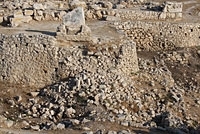Fieldwork campaign
Tell Balata Archaeological Park
The project aims at contributing to the safeguarding of Palestinian cultural heritage and the enhancement of economic situation through tourism development, by presenting and managing one of the most important archaeological resources, the archaeological site of Tell Balata.
- Contact
- Gerrit van der Kooij
- Funding
- Government of the Netherlands
- Partners
-
The Faculty of Archaeology of Leiden University (The Netherlands)
United Nations Educational, Scientific and Cultural Organization (UNESCO)

The project is a Joint Palestinian-Dutch expedition in cooperation with UNESCO (2010-2012). Funded by the Government of The Netherlands. The major activities of the project include scientific research and the formulation and implementation of a Management Plan. For this the three involved institutions MOTA-DACH, the University of Leiden (Faculty of Archaeology), and UNESCO, work closely together with local stakeholders to implement the project.
The project aims at contributing to the safeguarding of Palestinian cultural heritage and the enhancement of economic situation through tourism development, by presenting and managing one of the most important archaeological resources, the archaeological site of Tell Balata.
Tell Balata lays 2.5 Km East of the Historical Centre of Nablus and is important because of its cultural and historical significance in the past. The site is a key component of the potential World Heritage site “Old Town of Nablus and its environs”, one of twenty sites listed on the
Inventory of Cultural and Natural Heritage Sites of Potential Outstanding Universal Value in Palestine. However, the site is suffering from urban pressure and lack of an appropriate management. Therefore, the purpose of this project is to safeguard this important cultural heritage site from further deterioration and make it visitors-friendly.
The major activities of the project include scientific research and the formulation and implementation of a Management Plan. For this the three involved institutions MOTA-DACH, the University of Leiden (Faculty of Archaeology), and UNESCO, work closely together with local stakeholders to implement the project.
Tell Balata

Tell Balata is identified with ancient Shechem, known from several written sources, dating back to the 2nd and 1st millennia BC, and later ones. The site is located in the main hill-country of Palestine, between Mount Gerizim and Mount Ebal, at the crossing of the main north-south and east-west routes. The location has many water sources in addition to good winter rainfall and fertile land, thus providing good means of subsistence. Ancient Egyptian and other texts mention Sekmen or Shakmu, as well as its king Labayu during the 14 th century BC, when the town was the capital of a large city-state. This important position, though under Egyptian or other rule, was maintained up to 732 BC, when the city was destroyed by the Assyrians. Later on it was the centre of the Samaritan community until its final destruction in 128/107 BC.
Excavations have revealed the occupational history of the site, particularly during the Middle and Late Bronze Ages – the second urbanization period in Palestine – from around 2000 till ca 1100BC. Several impressive ruins from this period are visible, such as the ‘fortress’ temple on the summit of the hill, used for public worship. Other ruins include two monumental gates, massive city walls, and a governor's palace with a small private shrine, guardrooms, an assembly, living quarters, and a kitchen. Of the following Iron Age few remains are to be seen, but some other building remains date from Hellenistic times.
Later on the site of Balata was abandoned, but a new town was established by the Romans further west, in 72 AD, named Flavia Neapolis, called Nablus under the khalifs since 636 AD, continuously being a trading and agricultural centre in northern Palestine: called, together with Tell Balata in the past, “the uncrowned queen of Palestine”.
Implementation of the Archaeological Park
The project focuses on Tell Balata and has two main components: research and heritage management. Research concerns assessment of the site, including study of publications and doing fieldwork, and is currently taking place by a joint Palestinian-Dutch team, co-directed by Dr Hamdan Taha and Dr Gerrit van der Kooij. This includes a careful study of the results of the previous excavations by German teams from 1914-1934 and American ones from 1956-1969 with some later activities. Another aspect is tracing archival material and excavated objects, in order to develop an archive about the site and have objects available for exhibition.
This first year of fieldwork concerns cleaning of the site and clearance of the old trenches. In 2011 some additional excavations will take place, to clarify and add data, largely aiming at chronological clarity. Also some consolidations have to be done this first year, in order to stop gradual collapse at places. Another aspect of this season’s fieldwork is ‘community archaeology’: it is a goal of the project to bring local people in connection with this archaeological heritage, as part of their responsibility and their connection with the past. This year’s focus is on children, and organised with summer camps through the Multipurpose Community Resource Center in Nablus.
Consolidation and community archaeology are elements of management of the site. The Heritage Management Plan is being developed in cooperation with local stakeholders, and concerns presentation and promotion of the site, including a reception space, Interpretation Center, site museum, visit-trail, and written information. Some elements of it have to be partially or preliminarily implemented already this year, but it will be fully implemented the coming two years.
All information can be found on:
